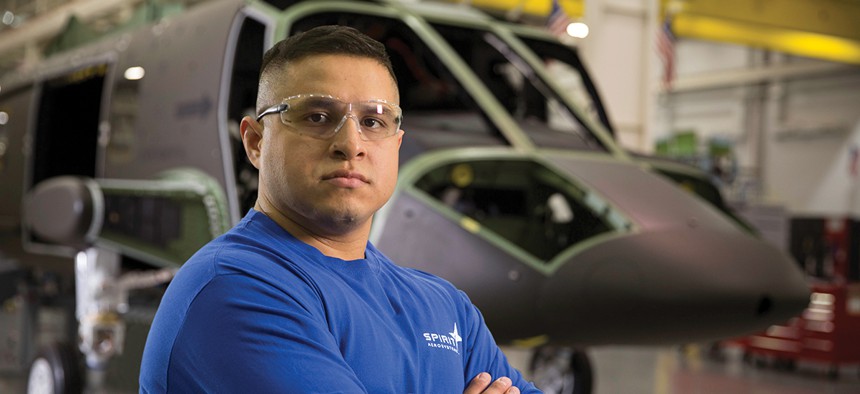sponsor content What's this?

Building a stronger defense industry with commercial best practices
With nine decades of experience designing and building aircraft, Spirit AeroSystems leverages best practices from the commercial sector to bring economy, efficiency and reliability to the defense aircraft industry.
Presented by Spirit AeroSystems
Military aircraft often have unique requirements reflecting their distinct missions. They must operate in adverse conditions, mission profiles differ from commercial aircraft and baggage compartments might be replaced by weapons bays. The design of some equipment and components might be classified, and manufacturing facilities might be secured and segregated from those for commercial aircraft. But this does not mean that the defense industry cannot benefit from the aviation industry’s decades of experience in designing and building aircraft for the commercial market.
Commercial aircraft typically are manufactured on a scale that provides greater economies and efficiencies, and experience in high-volume manufacturing helps to improve quality assurance. When the defense industry leverages the best practices employed in the production of commercial aircraft, its military customers benefit from a more robust, cost-effective and reliable end product.
Spirit AeroSystems, with nine decades of experience in aircraft design and manufacture, leverages this expertise to meet the evolving needs of the defense industry, enabling customers to execute critical missions in the face of rapidly changing threats and tightening budgets with no compromise in reliability or security.
A Pioneering Spirit
Spirit has deep roots in the aviation industry, with a history dating back to 1927, and has served as a pioneer for both commercial and defense aviation innovation. Within the defense realm specifically, Spirit has a legacy of producing military aircraft that have made some of the most important contributions to the nation’s security, including the iconic B-29 Superfortress of World War II and the B-52 Stratofortress in the nuclear age – and Spirit carries on this critical role today.
As the largest tier one aircraft component supplier in the world, Spirit specializes as the design-build integrator of some of the largest and most complex aircraft structures and is also one of the largest builders of non-metallic composite aircraft parts.
Beyond the design-build expertise, Spirit also excels in enhanced manufacturability. The use of cross-functional product teams enables the company to benefit from integrated research and development capabilities. With this approach, Spirit can also streamline efficiencies with the design and assembly of components and assure consistent quality throughout production processes.
Building a Stronger Defense
While military aircraft certainly differ from commercial aircraft in terms of cargo, missions and budget and security requirements – all of which impact design and manufacturing – many may not realize that some military aircraft are based on modified commercial designs. This can allow carryover of efficiencies from the commercial to the defense sector.
A major difference between the two types of aircraft is the rate of production, but Spirit has worked this in its favor to better deliver for its defense customers. Commercial planes are produced at much higher rates than the military versions. But because of the overlap in the platforms, the efficiencies of scale enjoyed on the commercial side can be passed along to the defense side.
By way of Spirit’s integrated production teams, the company has also identified opportunities by which improvements in commercial production also benefit the defense side. For example, when Spirit identified and implemented solutions to eliminate defects in the fuselage skin of a particular aircraft, both the commercial and military versions of the aircraft saw dramatic improvements in skin quality.
Spirit delivers value for its defense industry customers by taking advantage of the overlap in military and commercial aircraft platforms to apply best practices and advanced processes to both. This capability enables reliable and flexible production that can quickly adapt to evolving defense priorities and needs. The result is an aircraft designed and built to execute its military mission.